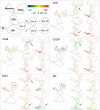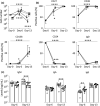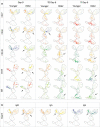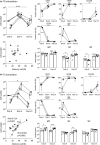B-cell capacity for differentiation changes with age
- PMID: 33711204
- PMCID: PMC8045946
- DOI: 10.1111/acel.13341
B-cell capacity for differentiation changes with age
Abstract
Background: Age-related immune deficiencies are thought to be responsible for increased susceptibility to infection in older adults, with alterations in lymphocyte populations becoming more prevalent over time. The loss of humoral immunity in ageing was attributed to the diminished numbers of B cells and the reduced ability to generate immunoglobulin.
Aims: To compare the intrinsic B-cell capacity for differentiation into mature plasma cells (PCs), between young and old donors, using in vitro assays, providing either effective T-cell help or activation via TLR engagement.
Methods: B cells were isolated from healthy individuals, in younger (30-38 years) and older (60-64 years) donors. An in vitro model system of B-cell differentiation was used, analysing 5 differentiation markers by flow cytometry, under T-dependent (TD: CD40/BCR stimulation) or T-independent (TI: TLR7/BCR activation) conditions. Antibody secretion was measured by ELISA and gene expression using qPCR.
Results: TI and TD differentiation resulted in effective proliferation of B cells followed by their differentiation into PC. B-cell-executed TI differentiation was faster, all differentiation marker and genes being expressed earlier than under TD differentiation (day 6), although generating less viable cells and lower antibody levels (day 13). Age-related differences in B-cell capacity for differentiation were minimal in TD differentiation. In contrast, in TI differentiation age significantly affected proliferation, viability, differentiation, antibody secretion and gene expression, older donors being more efficient.
Conclusion: Altogether, B-cell differentiation into PC appeared similar between age groups when provided with T-cell help, in contrast to TI differentiation, where multiple age-related changes suggest better capacities in older donors. These new findings may help explain the emergence of autoantibodies in ageing.
Keywords: B-cell differentiation; T-cell dependent; T-cell independent; ageing.
© 2021 The Authors. Aging Cell published by the Anatomical Society and John Wiley & Sons Ltd.
Conflict of interest statement
No conflicts of interest, financial or otherwise, are declared by the authors.
Figures





Similar articles
-
Toll-like receptor agonists synergize with CD40L to induce either proliferation or plasma cell differentiation of mouse B cells.PLoS One. 2011;6(10):e25542. doi: 10.1371/journal.pone.0025542. Epub 2011 Oct 3. PLoS One. 2011. PMID: 21991317 Free PMC article.
-
TLR7- and TLR9-responsive human B cells share phenotypic and genetic characteristics.J Immunol. 2015 Apr 1;194(7):3035-44. doi: 10.4049/jimmunol.1402690. Epub 2015 Mar 4. J Immunol. 2015. PMID: 25740945 Free PMC article.
-
B cell TLR1/2, TLR4, TLR7 and TLR9 interact in induction of class switch DNA recombination: modulation by BCR and CD40, and relevance to T-independent antibody responses.Autoimmunity. 2015 Feb;48(1):1-12. doi: 10.3109/08916934.2014.993027. Autoimmunity. 2015. PMID: 25536171 Free PMC article.
-
Determinations of B cell fate in immunity and autoimmunity.Curr Dir Autoimmun. 2005;8:1-24. doi: 10.1159/000082084. Curr Dir Autoimmun. 2005. PMID: 15564715 Review.
-
The ageing human B cell repertoire: a failure of selection?Clin Exp Immunol. 2016 Jan;183(1):50-6. doi: 10.1111/cei.12700. Epub 2015 Oct 6. Clin Exp Immunol. 2016. PMID: 26332693 Free PMC article. Review.
Cited by
-
Clinical application of mesenchymal stem cells in immunosenescence: a qualitative review of their potential and challenges.Stem Cell Res Ther. 2025 May 28;16(1):265. doi: 10.1186/s13287-025-04360-z. Stem Cell Res Ther. 2025. PMID: 40437519 Free PMC article. Review.
-
How aging impacts vaccine efficacy: known molecular and cellular mechanisms and future directions.Trends Mol Med. 2022 Dec;28(12):1100-1111. doi: 10.1016/j.molmed.2022.09.008. Epub 2022 Oct 7. Trends Mol Med. 2022. PMID: 36216643 Free PMC article. Review.
-
Pyrroloquinoline Quinone Reprograms the Single-Cell Landscape of Immune Aging in Hematopoietic Immune System.Aging Cell. 2025 Jul;24(7):e70050. doi: 10.1111/acel.70050. Epub 2025 Apr 7. Aging Cell. 2025. PMID: 40192736 Free PMC article.
-
Tobacco exposure, but not aging, shifts the frequency of peripheral blood B cell subpopulations.Geroscience. 2024 Apr;46(2):2729-2738. doi: 10.1007/s11357-023-01051-6. Epub 2023 Dec 29. Geroscience. 2024. PMID: 38157147 Free PMC article.
-
Metabolic Reprogramming During B-Cell Differentiation.Methods Mol Biol. 2023;2675:271-283. doi: 10.1007/978-1-0716-3247-5_20. Methods Mol Biol. 2023. PMID: 37258770
References
-
- Amir, E.‐A. , Davis, K. L. , Tadmor, M. D. , Simonds, E. F. , Levine, J. H. , Bendall, S. C. , Shenfeld, D. K. , Krishnaswamy, S. , Nolan, G. P. , & Pe'er, D. (2013). viSNE enables visualization of high dimensional single‐cell data and reveals phenotypic heterogeneity of leukemia. Nature Biotechnology, 31(6), 545–552. 10.1038/nbt.2594 - DOI - PMC - PubMed
MeSH terms
Substances
LinkOut - more resources
Full Text Sources
Other Literature Sources
Medical
Research Materials

